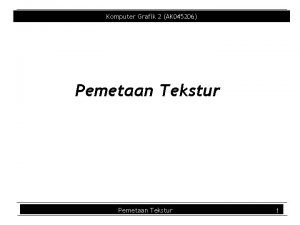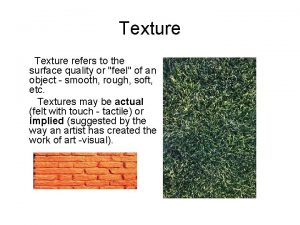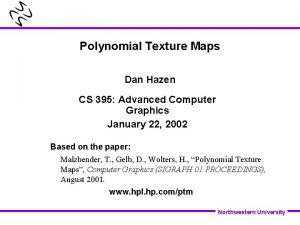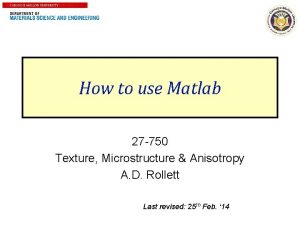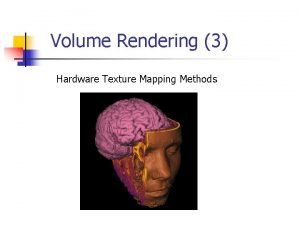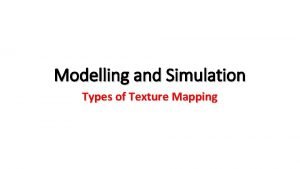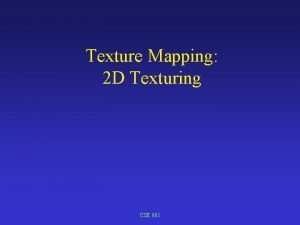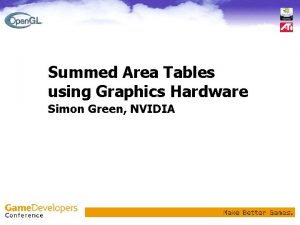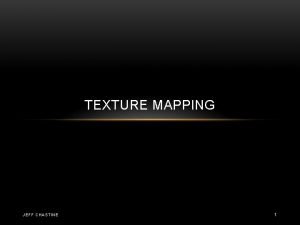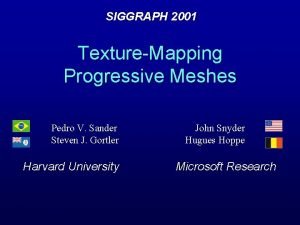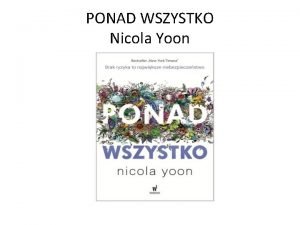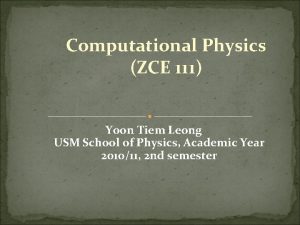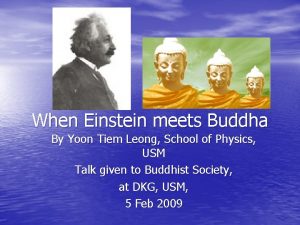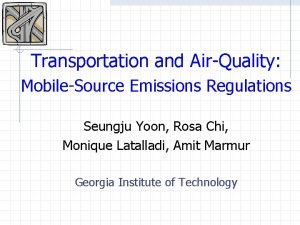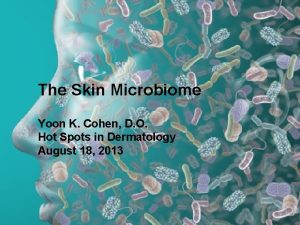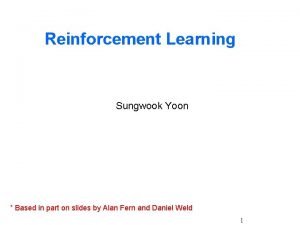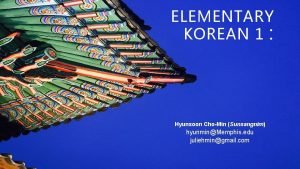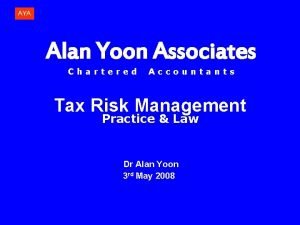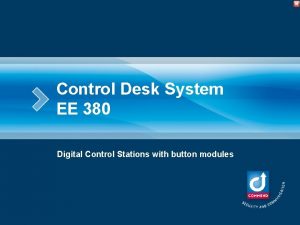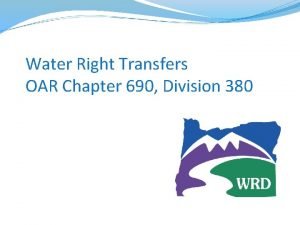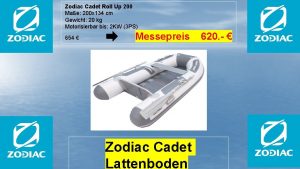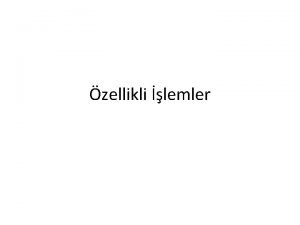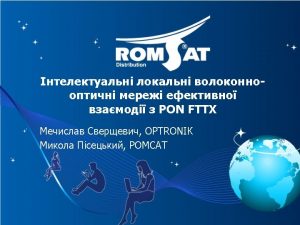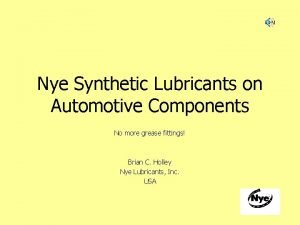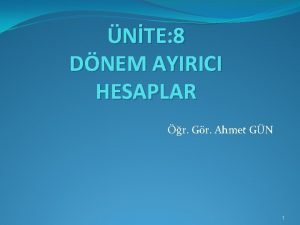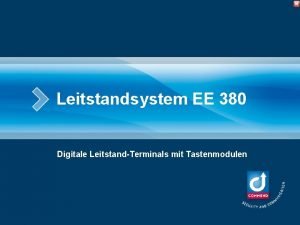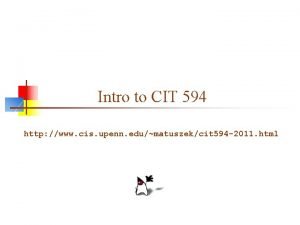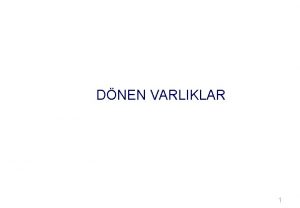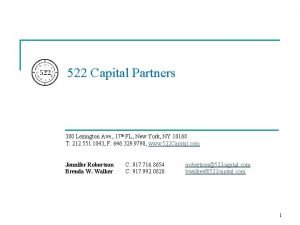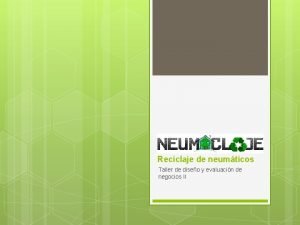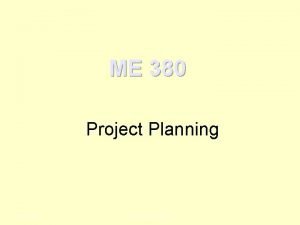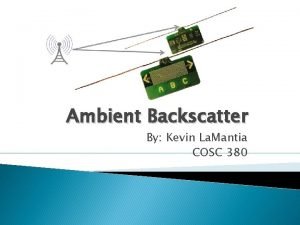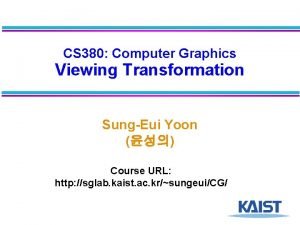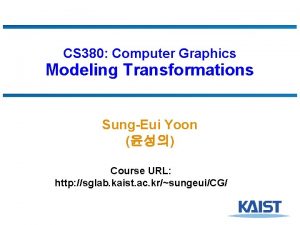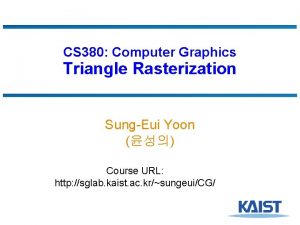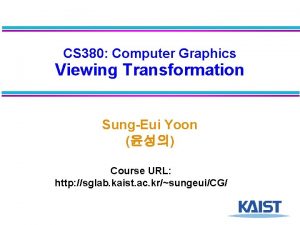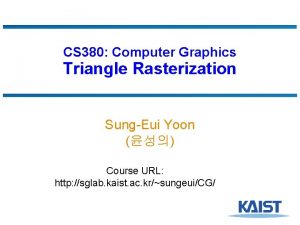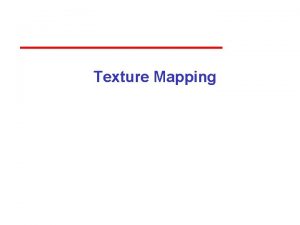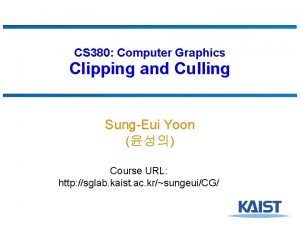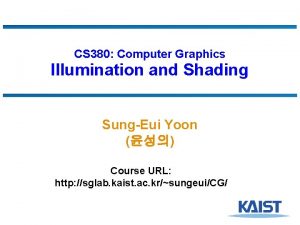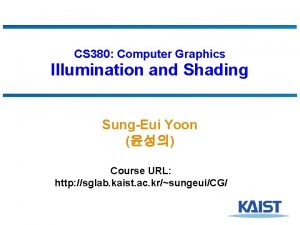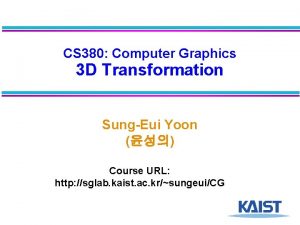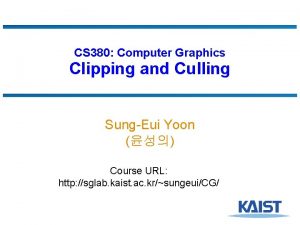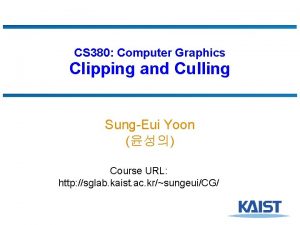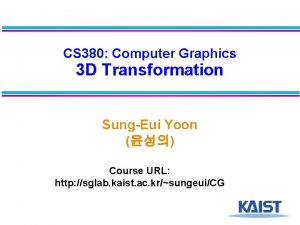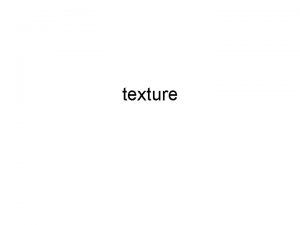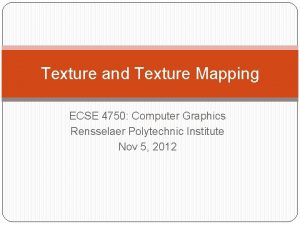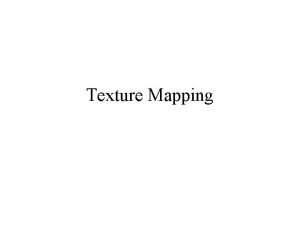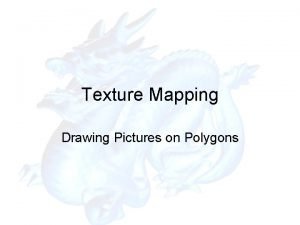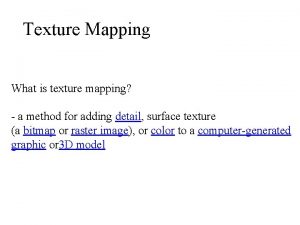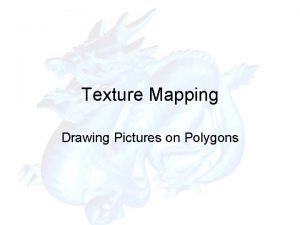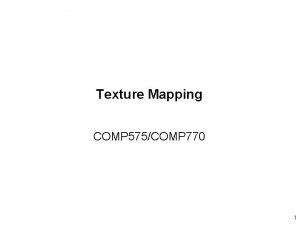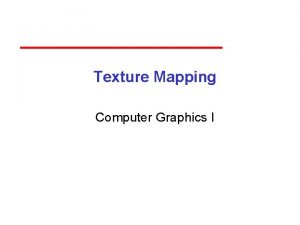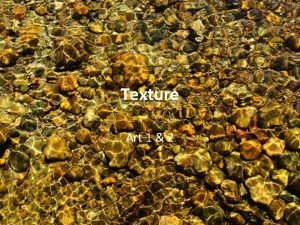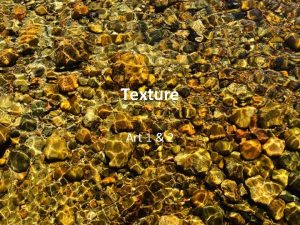CS 380 Computer Graphics Texture Mapping SungEui Yoon



















































- Slides: 51

CS 380: Computer Graphics Texture Mapping Sung-Eui Yoon (윤성의) Course URL: http: //sglab. kaist. ac. kr/~sungeui/CG

Class Objectives ● Texture mapping overview ● Texture filtering ● Various applications of texture mapping ● Related chapter of my book ● Chapter 9 “Texture” 2

Texture Mapping ● Requires lots of geometry to fully represent complex shapes of models ● Add details with image representations 3 Excerpted from MIT EECS 6. 837, Durand Cutler

The Quest for Visual Realism 4

Texture Mapping 5 From MMO-champion

Texture Maps in Open. GL (x 4, y 4) (u 4, v 4) (x 3, y 3) (u 3, v 3) ● Specify normalized texture coordinates at each of the vertices (u, v) ● Texel indices (s, t) = (u, v) (width, height) (x 1, y 1) (u 1, v 1) 6 (x 2, y 2) (u 2, v 2) gl. Bind. Texture(GL_TEXTURE_2 D, tex. ID) gl. Begin(GL_POLYGON) gl. Tex. Coord 2 d(0, 1); gl. Vertex 2 d(-1, -1); gl. Tex. Coord 2 d(1, 1); gl. Vertex 2 d( 1, -1); gl. Tex. Coord 2 d(1, 0); gl. Vertex 2 d( 1, 1); gl. Tex. Coord 2 d(0, 0); gl. Vertex 2 d(-1, 1); gl. End()

Wrapping ● The behavior of texture coordinates outside of the range [0, 1) is determined by the texture wrap options. gl. Tex. Parameteri(GL_TEXTURE_2 D, GL_TEXTURE_WRAP_S, wrap_mode ) gl. Tex. Parameteri(GL_TEXTURE_2 D, GL_TEXTURE_WRAP_T, wrap_mode ) 7 GL_CLAMP GL_REPEAT

Linear Interpolation of Texture Coordinates ● Simple linear interpolation of u and v over a triangle in a screen space leads to unexpected results ● Distorted when the triangle’s vertices do not have the same depth ● Perspective-correct interpolation (interpolation in the object space) is implemented 8

Sampling Texture Maps ● The uniform sampling pattern in screen space cooresponds to some sampling pattern in texture space that is not necessarily uniform Texture space Screen space y t x 9 s

Sampling Density Mismatch ● Sampling density in texture space rarely matches the sample density of the texture itself Oversampling (Magnification) 10 Undersampling (Minification)

Handling Oversampling sample texture 11 ● How do we compute the color to assign to this sample?

Handling Oversampling ● How do we compute the color to assign to this sample? ● Nearest neighbor – take the color of the closest texel texture 12

Handling Oversampling ● How do we compute the color to assign to this sample? ● Nearest neighbor – take the color of the closest texel ● Bilinear interpolation texture 13

Visual Comparison 14 Mag. filter: nearest Min. filter: linear Mag. filter: linear Min. filter: linear Original texture Mag. filter: linear Min. filter: mipmap

Undersampling ● Details in the texture tend to pop (disappear and reappear) ● Mortar (white substances) in the brick ● High-frequency details lead to strange patterns ● Aliasing 15

Spatial Filtering ● To avoid aliasing we need to prefilter the texture to remove high frequencies ● Prefiltering is essentially a spatial integration over the texture ● Integrating on the fly is expensive: perform integration in a pre-process Samples and their extents 16 Proper filtering removes aliasing

MIP Mapping ● MIP is an acronym for the Latin phrase multium in parvo, which means "many in one place" ● Constructs an image pyramid ● Each level is a prefiltered version of the level below resampled at half the frequency ● While rasterizing use the level with the sampling rate closest to the desired sampling rate ● Can also interpolate between pyramid levels ● How much storage overhead is required? 17

Storing MIP Maps ● One convenient method of storing a MIP map is shown below ● It also nicely illustrates the 1/3 overhead of maintaining the MIP map 18

Finding the MIP Level ● Use the projection of a pixel in screen into texture space to figure out which level to use 19

Summed-Area Tables ● Another way performing the prefiltering integration on the fly ● Each entry in the summed area table is the sum of all entries above and to the left: What is the sum of the highlighted region? 20 Divide out area (y 1 – y 0)(x 1 – x 0)

Summed-Area Tables ● How much storage does a summed-area table require? ● Does it require more or less work per pixel than a MIP map? ● Can be implemented in a fragment shader 21 Created by Denny

Texture Filtering in Open. GL ● Automatic creation glu. Build 2 DMipmaps(GL_TEXTURE_2 D, GL_RGBA, width, height, GL_RGBA, GL_UNSIGNED_BYTE, data) ● Filtering gl. Tex. Parameteri(GL_TEXTURE_2 D, GL_TEXTURE_MAG_FILTER, filter ) gl. Tex. Parameteri(GL_TEXTURE_2 D, GL_TEXTURE_MIN_FILTER, filter ) where filter is: GL_NEAREST GL_LINEAR_MIPMAP_LINEAR GL_NEAREST_MIPMAP_NEAREST GL_NEAREST_MIPMAP_LINEAR GL_LINEAR_MIPMAP_NEAREST 22 inter-level intra-level

Uses of Texture Maps ● Texture maps are used to add complexity to a scene ● Easier to paint or capture an image than geometry ● Model light ● Model geometry, etc One of key techniques to overcome various problems of rasterization techniques! 23

Modeling Lighting ● Light maps ● Supply the lighting directly ● Good for static environments ● Projective textures ● Can be used to simulate a spot light ● Shadow maps ● Environment maps ● A representation of the scene around an object ● Good for reflection 24

Light Maps in Quake ● Light maps are used to store pre-computed illumination Textures Only Textures & Light Maps Texture Maps Light Maps Data RGB Intensity Resolution High Low Light map image by Nick Chirkov 25

Projective Textures ● Treat the texture as a slide in a projector ● A good model for shading variations due to illumination (cool spotlights) ● Projectors work like cameras in reverse ● Camera: color of point in scene color of corresponding pixel ● Projector: color of pixel color of corresponding point in the scene 26

Shadow Maps Use the depth map in the light view to determine if sample point is visible Depth map from eye Depth map from light Point in shadow visible to the eye, but not visible to the light 27

Environment Maps ● Simulate complex mirror-like objects ● Use textures to capture environment of objects ● Use surface normal to compute texture coordinates View 28 Spherical env. map

Environment Maps - Example T 1000 in Terminator 2 from Industrial Light and Magic 29

Cube Maps ● Maps a viewing direction b and returns an RGB color ● Use stored texture maps 30

Cube Maps ● Maps a viewing direction b and returns an RGB color ● Assume b = (x, y, z), - Identify a face based on magnitude of x, y, z -For the right face, compute texture coord. (u, v) u = (y+x)/(2 x) v = (z+x)/(2 x) 31

Environment Maps - Problems ● Expensive to update dynamically ● Not completely accurate ● One of main reason that Cars (Pixar movie of 2006) used ray tracing images from NVIDIA Reflection of swimming pool is wrong 32

Environment Maps - Problems ● Expensive to update dynamically ● Not completely accurate ● One of main reason that Cars (Pixar movie of 2006) used ray tracing 33

Modeling Geometry ● Store complex surface details in a texture rather than modeling them explicitly ● Bump maps ● Modify the existing normal ● Normal maps ● Replace the existing normal ● Displacement maps ● Modify the geometry ● Opacity maps and billboards ● Knock-out portions of a polygon using the alpha channel 34

Bump Mapping ● Modifies the normal not the actual geometry ● Texture treated as a heightfield ● Partial derivatives used to change the normal ● Causes surface to appear deformed by the heightfield + 35 =

More Bump Map Examples + = Note that silhouette edge of the object not affected! 36

Normal Mapping ● Replaces the normal rather than tweaking it 37

Displacement Mapping ● Texture maps can be used to actually move surface points 38

Opacity Maps RGB channels alpha channel 39 Use the alpha channel to make portions of the texture transparent

Billboards Replace complex geometry with polygons texture mapped with transparent textures 40

3 D or Solid Textures ● Solid textures are three dimensional assigning values to points in 3 space ● Very effective at representing some types of materials such as marble and wood ● Generally, solid textures are defined procedural functions rather than tabularized functions as used in 2 D 41

Class Objectives were: ● Texture mapping overview ● Texture filtering ● Various applications of texture mapping 42

Next Time ● Visibility and ray tracing 43

Homework ● Go over the next lecture slides before the class ● No more video abstract submissions on June 44

Figs 45

(x 4, y 4) (u 4, v 4) (x 3, y 3) (u 3, v 3) (x 1, y 1) (u 1, v 1) (x 2, y 2) (u 2, v 2) 46

Texture space Screen space y v x u 47

Handling Oversampling sample texture 48 Bi-linear interpolation

Summed-Area Tables Original texture Summed-area table 49

Shadow Maps Depth map from eye 50 Depth map from light

Environment Maps View Spherical env. map 51
 What is texture in computer graphics
What is texture in computer graphics Most of the graphics monitors today operate as
Most of the graphics monitors today operate as Introduction to computer graphics - ppt
Introduction to computer graphics - ppt Simulated texture example
Simulated texture example What is polynomial texture mapping (ptm)?
What is polynomial texture mapping (ptm)? Matlab texture mapping
Matlab texture mapping Texture mapping algorithm
Texture mapping algorithm Texture mapping types
Texture mapping types 2d texture mapping
2d texture mapping Summed-area tables for texture mapping
Summed-area tables for texture mapping Texture mapping
Texture mapping Pedro v. sander
Pedro v. sander Ponad wszystko - nicola yoon
Ponad wszystko - nicola yoon Sung-eui yoon
Sung-eui yoon Yoon tiem leong
Yoon tiem leong Yoon tiem leong
Yoon tiem leong Yoon seungju
Yoon seungju Summary of superhuman by nicola yoon
Summary of superhuman by nicola yoon Erytherasma
Erytherasma Tai hyun yoon
Tai hyun yoon Sungwook yoon
Sungwook yoon Sunsangnim
Sunsangnim Alan yoon associates
Alan yoon associates Memory parameters
Memory parameters Forward mapping vs backward mapping
Forward mapping vs backward mapping Prinsip analisis dan desain
Prinsip analisis dan desain Ssis-380
Ssis-380 Ee 380
Ee 380 690-380
690-380 725 en yakın yüzlüğe yuvarlama
725 en yakın yüzlüğe yuvarlama Zodiac fastroller 380
Zodiac fastroller 380 380 gelir tahakkukları
380 gelir tahakkukları Romsat.ua
Romsat.ua Nye synthetic oil 605
Nye synthetic oil 605 18 gelecek aylara ait giderler ve gelir tahakkukları
18 gelecek aylara ait giderler ve gelir tahakkukları Ee 380
Ee 380 Cit 594
Cit 594 Dönem ayirici hesaplar 180 181 280 281 380 381
Dönem ayirici hesaplar 180 181 280 281 380 381 380 lexington ave
380 lexington ave 507-802-380
507-802-380 Me 380
Me 380 Sin values
Sin values Kevin 380
Kevin 380 Crt in computer graphics
Crt in computer graphics Define viewing in computer graphics
Define viewing in computer graphics What is plasma panel display in computer graphics
What is plasma panel display in computer graphics In two dimensional viewing we have?
In two dimensional viewing we have? Shear transformation in computer graphics
Shear transformation in computer graphics Shader computer graphics
Shader computer graphics Define scan conversion in computer graphics
Define scan conversion in computer graphics Equation of motion of a rotating rigid body
Equation of motion of a rotating rigid body Area filling
Area filling
